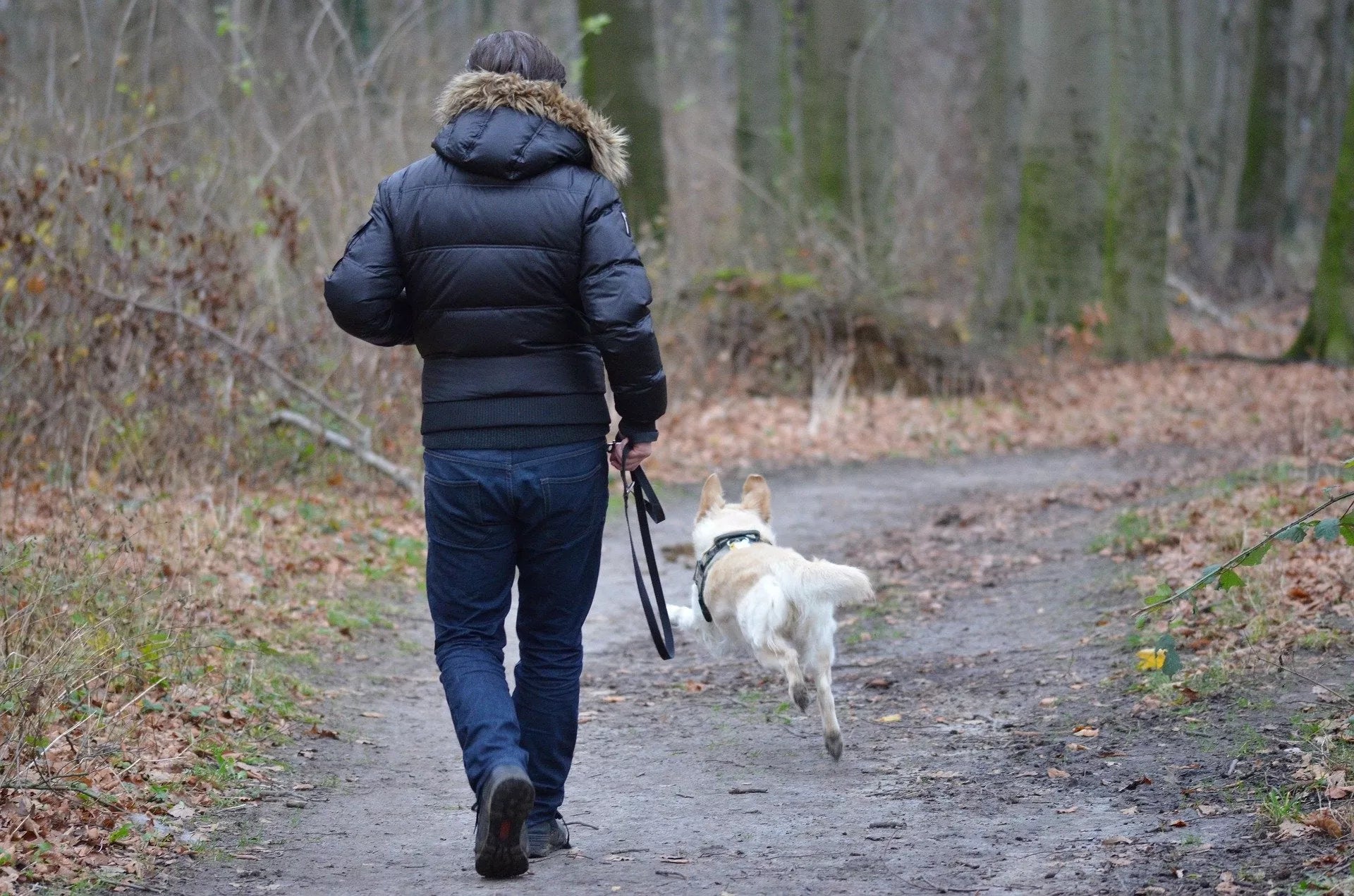Running With Your Dog - What You Need To Know

Did you hear about the guy in California, who with the help of his Weimaraner dog broke the unofficial human-dog 1 mile record?
They both clocked an incredible 4:13, which is a brilliant time. To be honest 4:13 is a bit quick for me, even if I had one heck of a tail wind and an energetic and enthusiastic canine pulling me along I wouldn't get close to that.

I am more of a 6 minute mile guy and around 75 minutes for 10 miles so you could say my speedy days are behind me. But as a 50+ year old guy who has now found a new passion for running, it is so great to join forces with a partner who also loves to run - whether they be of the two or four-legged variety.
As most runners will know, it is not always about the time. There is something inherently wonderful about running at a pace where you are so comfortable and in some cases feel that you are actually gliding along with little effort at all. I confess that it took me some time to get to this point and I now understand this is a combination of stamina, fitness, strength and base miles. And of course there is the wonderful 'high' runners can get during and after running. I wonder if it's the same for dogs?
As we know, some dogs have more of an instinct to run, especially if it forms part of what they were bred to do. But there is no doubt that dogs are exuberant animals and they love to run. Our dogs would much prefer to run than walk, although they would normally pick up on the fact that running usually works hand-in-hand with games of fetch, agility courses or play of some description, so they get very excited when our enthusiasm matches the pitch of our voices.
One thing is for sure - running has certainly not been bred out of dogs as they became domesticated. Many breeds of dog have running in their lineage, including Huskies, Border Collies and even the Dalmatian.
So if you are wondering about whether you are forcing your dog to run with you when it really doesn't want to..... don't. And to make a final point about this. Do you think the aforementioned Weimariner would run a super quick mile with it's owner if it didn't enjoy it or really didn't want to - if it didn't want to do, it wouldn't do it.
So which breeds of dog are suitable to run with?
Well, you'll be pleased to know that most dog breeds are suitable as running companions, but there are a few breeds who may not be able to handle much more than a short jog or walk around the block. Breeds like pugs and other short nose dogs can struggle when it comes to stamina, especially in hot or humid conditions, so it is worth assessing the fitness and suitability of these breeds before embarking on a run.
You should also take a look at the muscle structure and density of your dog. Breeds that have a lot of muscle will probably be built for sprinting short distances, rather than going on 10 mile runs. Dogs with high muscle density like Greyhounds and Boxers can overheat more quickly so always read up on your breed before taking your dog on a long jog or hike!
Some of the best breeds for running include Pointers, Setters, Huskies, Vislazs, Collies, Labradors and cattle dogs, but always take into account the age of your dog and its overall condition before you start.
What is the minimum age for a dog to start running?
Ideally, you want to wait until your dog is 12-18 months old. Some of the smaller breeds are mature (in terms of bone, growth plates and muscle development) at 12 months and for some larger breeds you should wait until your dog is around 18 months old. Check with your local breeder or dog club to get a better idea of when to start.
Do I need to get the opinion of a vet?
I would encourage you to do this before you go out on a long run. This is because a vet will notice if your dog has any gait issues. The vet will assess how your dog walks and make you aware of any problems.
Some dogs can walk with a slight limp or have problems with their toes or paws. Others may have conditions like hip dysplasia and other joint problems and your vet can check for this before you think about running with your dog.
Can I over work my dog when running?
Well, it is possible to work your dog too hard but this really does depend on a number of different factors. The breed and its inherent capabilities are a big factor. As I mentioned before, some breeds can handle longer runs better than others. Another thing to think about is how warm it is when you run.
Remember, that if your dog has a thick coat it will be more prone to overheating more quickly so be mindful of this before setting out on a run.

One other important thing to mention is that dogs don't really have an automatic shut off valve or sensor that tells them that enough is enough. They are so excited to be out running with you and they have absolutely no idea about pacing themselves. This is something that you have to decide for them. Don't push your dog and always check to see that he/she does not look tired or that they are panting heavily.
You can set the pace and test your dog on shorter runs first. If it appears to be comfortable on a 1 or 2 mile run, stick with this distance for a couple of weeks and then try a 3 or 5 mile run. Always check to see if your dog is happy and that it recovers well. And remember, a 10 year old dog is really 70 in human years and may not be up to the task at this age.
What kit do I need before I run with my dog?
You'll need to set yourself up for the task first and then move onto your dog. Make sure you have the right kit including shoes, socks and comfortable running clothes. If you want to be 'hands free' when you run why not invest in a hands free bungee style dog training lead. This will fasten around your waist and will cushion any pulling forces. You can then fit your dog with a collar or harness so you can attach the lead to something.
You may want to get a harness, but make sure it does not cover a very large part of the torso. Also, it should not restrict your dog's breathing and it needs sufficient freedom for the shoulders. Some people prefer a standard collar, but I find it harder to control my dog with a collar and I do wonder about pulling forces around the neck, especially if I slip and fall over. One thing to point out is that it is YOUR run and the dog is coming along for the ride.
Don't let your dog control it and don't let it pull you along and go way out in front. Try to teach your dog that it must be fairly close to your side and reward it when it behaves well and sticks to this - reinforcing good behaviour from the start is the best way to go. This could mean a bit of a learning curve for a few runs but it will be worth it in the end.
Of course, your dog can't drink from a bowl or river while running, but in many cases you won't want to disrupt your run. Be sensible by taking into account how your dog is feeling and whether it is hydrated.
Even though it is a pain to stop for a drink, if your dog needs to stop and looks uncomfortable, then do it. Only you'll know if you need to do this. You can carry a fold up dog water bowl and you can attach this to your belt, loop or other item of clothing.
What about toilet breaks when I am running with my dog?
You don't really want to stop 2 miles into a 5 mile run so your dog can go to the toilet. You can get into a routine of teaching your dog that a walking warm up (before you run) or walking cool down (after the run) is the best time to go to the toilet. It is far better to carry a poo bag for 200 yards than for 3 miles! However, if your dog really needs to go during the main run, you'll just have to stop.
How do I get into Canicross?
Unlike standard running or jogging (when the dog is ideally at your side), in Canicross it can be a very different story. This activity requires the human to be the driver but to mainly offer voice commands from the rear. This means that you can use general or musher terms (musher means a transport method powered by dogs) and this helps to keep your dog on track.

If you use general terms like 'left' and 'right' in your agility or obedience training then there is no reason why you shouldn't stick with this. There are also other commands you can use to make your dog go faster or to keep at a steady pace. It is up to you which terms or commands you use for this, but why not experiment until you are both happy. One thing to mention is always try to think of command words that do not sound very similar to common words like sit, stay, come etc. And remember to always praise your dog and reinforce good behaviour so they learn quickly.
As far as trying it out competitively, I am sure there are Canicross events near you, where you can go along and meet and chat to other competitors to get a feel of it. More often than not, you'll find dog owners to be a very friendly and social bunch.
Above all, running will get you fit and will only improve on the bond you have with your dog. It's a bit of a win-win really!
Sammi Long is a dog blogger and owns wiggles and wags pet store in the UK. You can view a range of running dog harness products as well as dog running lead
-
Posted in
canicross, jogging with my dog, running with your dog





